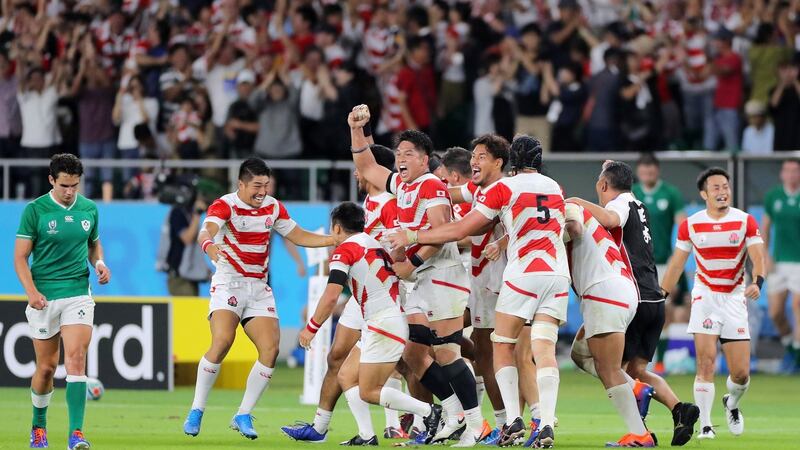How to frame one of the most amazing games of rugby I’ve ever seen; in defeat?
Maybe by taking Friday's 'rewards' and overlaying it on Japan. I had been referring to rewards from referees but today I wonder about playing styles rewards. I'll base this on scrum, lineout, general play, defence and finally the opposition.
The scrum
It drives me insane when people poo-poo the scrum. It is, along with touring, the key differential between our sport and all others. On Saturday we experienced the value of same with scrums accounting for similar occurrences as platforms; 13 versus 19 lineouts but what an emotional, physical, psychological fillip that 35th-minute scrum penalty gave Japan.
Half-time soon approached and the score was 12-9 to Ireland but in the heat and humidity the Irish looked exactly what they were – exhausted – as Japan cantered off.
Ironically, the Japanese having hinted at Cian Healy's illegality in set-up, mimicked as much when Japanese loosehead Keita Inagaki set up in the similar fashion; wide and outside Tadhg Furlong. This sucked his hooker, Shota Horie, onto Furlong, making life very difficult for the tighthead.
Referee interpretation is difficult as I couldn’t hear his instructions but the entire Japanese nation sucked all the Irish energy in that scrum-penalty moment.
Fast forward to Japan's try and you'll notice the solidity of their scrum platform and how it's perfect timing allowed centre Ryoto Nakamura to hit hard and fast off a flat pass; gainline crossed. Next, an intricate play from Lomano Lemeki who switches against the troubled Irish defence. They continue the same way with two quality, accurate passes from Nakamura with the second a beautiful one-move catch and pass by Timothy Lafaele to Kenki Fukuoka, who scores. Never ever doubt the value of the scrum especially when extremely fatigued in the humid conditions. What tighthead options Joe Schmidt explores over coming matches will be intriguing.
The lineout
Thus far the five-man lineout has proven to be the most successful for all sides. Ireland's first lineout was to the front, hitting James Ryan. The second hit Peter O'Mahony in the middle and so on but Ireland didn't bully Japan in the expected lineout maul to stifle the home side.
In fact worse occurred.
The famed Irish attacking platform resorted to front of the lineout, off the top ball, with a backline move thrown in. Yes, the ball eventually got to Jacob Stockdale but along with triple-team defence. The lineout missed its target twice (mind you Seán Cronin nailed his pressure throws) but mistakes occur. That's not why Ireland lost. We lost partly because the lineout was incapable of bullying a Japanese pack like it did Scotland, as Japan sacked our maul or simply stopped it.
Bravo Japan.

General play
Ireland’s last score was almost an hour before the final whistle. Why? The gainline. Contrast and compare the Japanese backrow who have an entirely different continuity concept on the ball. Our ball carriers, O’Mahony and CJ Stander, offer for carries that invariably result in a one out smash on the defender.
In the Irish number seven jersey against Wales, O’Mahony displayed wider ambition of tip ons, spin passes etc, but on Saturday Stander, O’Mahony, et al find their defender when the Japanese find the weakness.
Japan dance while powering forward, with the chain of three Irish defenders unsure who will have to make the tackle, forcing a later defensive set up of the Irish defender, resulting in metres conceded.
The converse is not true. It is never easy to tackle a ball carrier of Stander’s athleticism but there is zero decision making in making the tackle. This is a huge difference and one Japan won with ease, ensuring pacey recycle and gainline dominance where Ireland’s front five couldn’t slow Japan’s ambition and recycle.
Japan also had much more speed, accuracy and width in their game approach. No lumbering one-out slow carrying from a standing start. In fact if they can solve their 10th-phase error count they will do even more damage.
Defence
Japan had 176 tackles to make and made 92 per cent of them. Ireland had 171 tackles and made 89 per cent of them. Precious few were square-on, shuddering stops with many the result of a weak shoulder impact and gainline concession.
With 19 kicks from hand each off similar possession, look at 503 Japanese metres to Ireland’s 318 and a story begins to evolve; what are Ireland doing with the ball, especially when not winning collisions? Far too often the Irish first receiver took it standing and the subsequent breakdown was either poorly resourced or overly resourced. The first led to penalties and turnovers, the second led to a poor attacking outcome; both losses.
Back to that 35th-minute penalty scrum; take a look at Jack Carty carrying into a double team defensive hit producing the Japanese knock-on and the subsequent scrum; no joy there. Why? Iain Henderson had carried immediately before; took it standing, was chopped down requiring three Irish forwards to seal off and without options, Carty ran into a double wall and boom, scrum and penalty against Ireland. A bad carry followed by a bad carry followed by a bad scrum. Half-time 12-9 and game over?
The opposition
I couldn’t but rejoice in the spectacle the Japanese subjected me too. They are marvellous in every sense of the word. They met Ireland toe to toe, dominated the scrum (at times), the lineout (at times) but throughout they gave us a lesson in the value of the ball. It is a precious commodity requiring a precious game plan.















